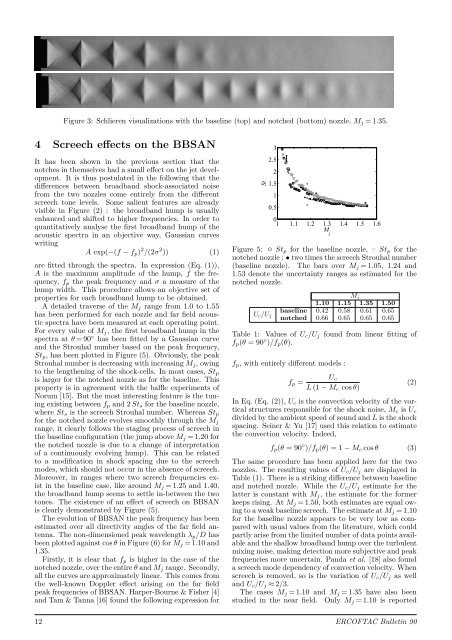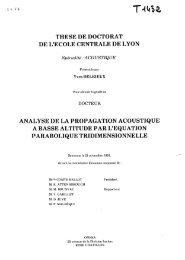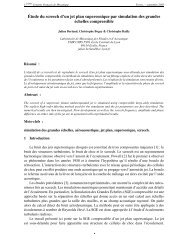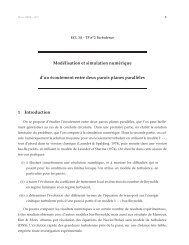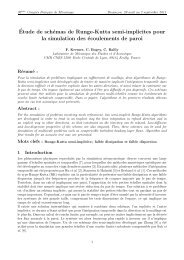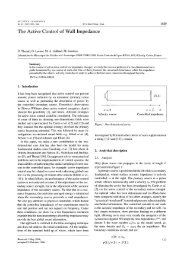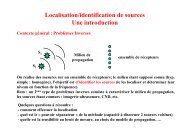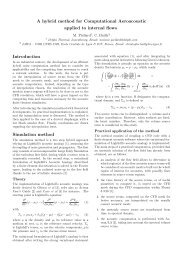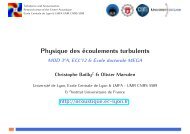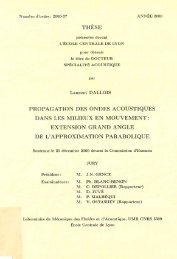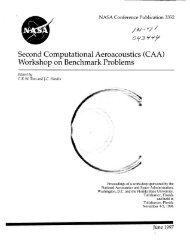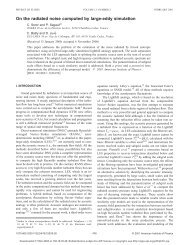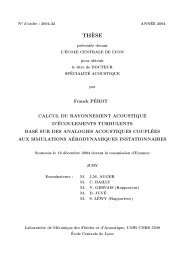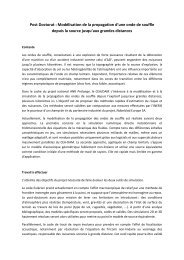ERCOFTAC Bulletin - Centre Acoustique
ERCOFTAC Bulletin - Centre Acoustique
ERCOFTAC Bulletin - Centre Acoustique
You also want an ePaper? Increase the reach of your titles
YUMPU automatically turns print PDFs into web optimized ePapers that Google loves.
Figure 3: Schlieren visualizations with the baseline (top) and notched (bottom) nozzle, Mj = 1.35.<br />
4 Screech effects on the BBSAN<br />
It has been shown in the previous section that the<br />
notches in themselves had a small effect on the jet development.<br />
It is thus postulated in the following that the<br />
differences between broadband shock-associated noise<br />
from the two nozzles come entirely from the different<br />
screech tone levels. Some salient features are already<br />
visible in Figure (2) : the broadband hump is usually<br />
enhanced and shifted to higher frequencies. In order to<br />
quantitatively analyse the first broadband hump of the<br />
acoustic spectra in an objective way, Gaussian curves<br />
writing<br />
A exp(−(f − fp) 2 /(2σ 2 )) (1)<br />
are fitted through the spectra. In expression (Eq. (1)),<br />
A is the maximum amplitude of the hump, f the frequency,<br />
fp the peak frequency and σ a measure of the<br />
hump width. This procedure allows an objective set of<br />
properties for each broadband hump to be obtained.<br />
A detailed traverse of the Mj range from 1.0 to 1.55<br />
has been performed for each nozzle and far field acoustic<br />
spectra have been measured at each operating point.<br />
For every value of Mj, the first broadband hump in the<br />
spectra at θ = 90 ◦ has been fitted by a Gaussian curve<br />
and the Strouhal number based on the peak frequency,<br />
Stp, has been plotted in Figure (5). Obviously, the peak<br />
Strouhal number is decreasing with increasing Mj, owing<br />
to the lengthening of the shock-cells. In most cases, Stp<br />
is larger for the notched nozzle as for the baseline. This<br />
property is in agreement with the baffle experiments of<br />
Norum [15]. But the most interesting feature is the tuning<br />
existing between fp and 2 Sts for the baseline nozzle,<br />
where Sts is the screech Strouhal number. Whereas Stp<br />
for the notched nozzle evolves smoothly through the Mj<br />
range, it clearly follows the staging process of screech in<br />
the baseline configuration (the jump above Mj = 1.20 for<br />
the notched nozzle is due to a change of interpretation<br />
of a continuously evolving hump). This can be related<br />
to a modification in shock spacing due to the screech<br />
modes, which should not occur in the absence of screech.<br />
Moreover, in ranges where two screech frequencies exist<br />
in the baseline case, like around Mj = 1.25 and 1.40,<br />
the broadband hump seems to settle in-between the two<br />
tones. The existence of an effect of screech on BBSAN<br />
is clearly demonstrated by Figure (5).<br />
The evolution of BBSAN the peak frequency has been<br />
estimated over all directivity angles of the far field antenna.<br />
The non-dimensioned peak wavelength λp/D has<br />
been plotted against cos θ in Figure (6) for Mj = 1.10 and<br />
1.35.<br />
Firstly, it is clear that fp is higher in the case of the<br />
notched nozzle, over the entire θ and Mj range. Secondly,<br />
all the curves are approximately linear. This comes from<br />
the well-known Doppler effect arising on the far field<br />
peak frequencies of BBSAN. Harper-Bourne & Fisher [4]<br />
and Tam & Tanna [16] found the following expression for<br />
St<br />
3<br />
2.5<br />
2<br />
1.5<br />
1<br />
0.5<br />
0<br />
1 1.1 1.2 1.3 1.4 1.5 1.6<br />
M j<br />
Figure 5: ◦ Stp for the baseline nozzle, ▽ Stp for the<br />
notched nozzle ; • two times the screech Strouhal number<br />
(baseline nozzle). The bars over Mj = 1.05, 1.24 and<br />
1.53 denote the uncertainty ranges as estimated for the<br />
notched nozzle.<br />
Uc/Uj<br />
Mj<br />
1.10 1.15 1.35 1.50<br />
baseline 0.42 0.58 0.61 0.65<br />
notched 0.66 0.65 0.65 0.65<br />
Table 1: Values of Uc/Uj found from linear fitting of<br />
fp(θ = 90 ◦ )/fp(θ).<br />
fp, with entirely different models :<br />
fp =<br />
Uc<br />
L (1 − Mc cos θ)<br />
(2)<br />
In Eq. (Eq. (2)), Uc is the convection velocity of the vortical<br />
structures responsible for the shock noise, Mc is Uc<br />
divided by the ambient speed of sound and L is the shock<br />
spacing. Seiner & Yu [17] used this relation to estimate<br />
the convection velocity. Indeed,<br />
fp(θ = 90 ◦ )/fp(θ) = 1 − Mc cos θ (3)<br />
The same procedure has been applied here for the two<br />
nozzles. The resulting values of Uc/Uj are displayed in<br />
Table (1). There is a striking difference between baseline<br />
and notched nozzle. While the Uc/Uj estimate for the<br />
latter is constant with Mj, the estimate for the former<br />
keeps rising. At Mj = 1.50, both estimates are equal owing<br />
to a weak baseline screech. The estimate at Mj = 1.10<br />
for the baseline nozzle appears to be very low as compared<br />
with usual values from the literature, which could<br />
partly arise from the limited number of data points available<br />
and the shallow broadband hump over the turbulent<br />
mixing noise, making detection more subjective and peak<br />
frequencies more uncertain. Panda et al. [18] also found<br />
a screech mode dependency of convection velocity. When<br />
screech is removed, so is the variation of Uc/Uj as well<br />
and Uc/Uj ≈ 2/3.<br />
The cases Mj = 1.10 and Mj = 1.35 have also been<br />
studied in the near field. Only Mj = 1.10 is reported<br />
12 <strong>ERCOFTAC</strong> <strong>Bulletin</strong> 90


